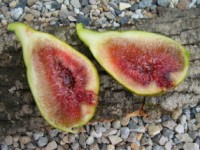|
|
| Dalmatie |

In the French garden centers, it is possible to find at least two distinct varieties of fig trees that are named "Dalmatie" ; one with green-violet fruits and one with green fruits. The following description is exclusively related to the green-fruited variety, as described for the first time in 1904 by Trabut.
This fig tree is supposed to originate from the island of Lesina (Hvar), in the Dalmatian coast (Croatia).
Dalmatie is a small-sized fig tree, with weak growth and little vigor that has a “bare” appearance, as the branches have little or no ramification and few deeply cut leaves.
The resistance to cold is very high and is probably also increased by the lack of vigor of the new growth in Spring and the fast hardening of its wood in Summer.
The tree bears many breba fruits in Spring, but they really can’t stand temperatures variations which make them massively fall. Besides the excellent taste and large fruit-size, this fig tree should not be grown for brebas production as the rare fruits that ripen delay the subsequent heavy main crop significantly.
The main crop fruits are very big and look enormous when compared to the small size of the tree. The fruit is very dense, sugared and surprisingly, if it rains a little before harvesting, then it becomes juicier without losing its qualities. When perfectly ripe, a drop of sugary honey flows from the eye.
The main crop of this variety is late and may not ripen; therefore suppressing all the breba crop, while at the size of peas may reduce the ripening time of the main crop by one to three weeks. In addition, the number of new sprouts that the plant produces must be controlled, because they also slow down the fruit maturity. The ideal case is to let these sprouts grow only those years when the warm season starts earlier than usual, to add or renew some branches that will eventually bear new fruits.
To conclude, this amazing, small-sized fig tree, highly resistant to cold, deserves a little space in the garden for the production of huge and excellent main crop fruits.
|
| |
| General data |
| Origin |
Croatia |
| Synonym(s), local names |
San Pietro, Du Japon, Blanche Navello |
| Tree type |
Common |
| Crop |
Biferous |
| |
| Tree morphological characteristics |
| Shape |
Erected |
| Vigor |
Weak |
| Ability to produce suckers |
Medium |
| Height after 10 years |
250 cm |
| Width after 10 years |
200 cm |
| Minimum width |
150 cm |
| |
| Branch morphological characteristics |
| Branch color |
Brown red |
| Caliber |
Medium |
| Buds |
Red, pink |
| |
| Leaves morphological characteristics |
| Leaves |
Small |
| Lobs |
7 |
| Depth |
Very deep sinuses |
| |
| Adaptation outside the Mediterranean area |
| Cold hardiness |
Excellent |
| Wind resistant |
Excellent |
| Pot culture |
|
 
| Yield |
Almost none |
| Fruits dropping |
High fruit drop |
| Alternance |
Weak |
| Sensitivity to splitting |
Very resistant |
| Crop begin date (day-month) |
Valleiry:24-07 |
| |
| External characteristics |
| Skin color |
Green, yellow |
| Skin thickness |
Thick |
| Shape |
Pyriform |
| Stalk |
Breaks off readily |
| Stalk shape |
|
| Neck |
Quite long |
| Neck color |
|
| Eye |
Big, opened |
| Eye color |
|
| Average weight (grams) |
150 g |
| |
| Internal characteristics |
| Pulp color |
Light red |
| Seeds |
Felt, many |
| |
| Organoleptic evaluation |
| Texture |
Juicy |
| Sugar |
Very sweet |
| Taste |
Excellent |
| Perfume |
Medium |
| Organoleptic descriptors |
|
   
| Yield |
Good |
| Fruits dropping |
No fruit drop |
| Alternance |
None |
| Sensitivity to splitting |
Resistant |
| Crop begin date (day-month) |
Valleiry:28-09 |
| |
| External characteristics |
| Skin color |
Green, yellow |
| Skin thickness |
Thick |
| Shape |
Pyriform |
| Stalk |
Does not break off readily |
| Stalk shape |
Short and medium |
| Neck |
Long |
| Neck color |
Green, yellow |
| Eye |
Big, opened |
| Eye color |
Light red |
| Average weight (grams) |
93 g |
| |
| Internal characteristics |
| Pulp color |
Dark red |
| Seeds |
Felt, many |
| |
| Organoleptic evaluation |
| Texture |
Pasty |
| Sugar |
Sweet |
| Taste |
Very good |
| Perfume |
Medium |
| Organoleptic descriptors |
Honey, Strawberry |
   
|










